Porcelain Insulator News
by Elton Gish
Reprinted from "Crown Jewels of the Wire", January 2000, page 12
The first insulator we will report this month is one I acquired a few years
ago. The crown is unusual in that the cutout under the cable groove is pointed.
At first I thought this was a new style but a search of the U-Chart showed it to
be U-570. The drawing in the U-Chart does not show the crown detail because it
was taken from a catalog drawing. James Lindsey, Jr. (NIA #3750) reported two
U-570's one of which was marked THOMAS on the crown. Bill Rohde (NIA #1219) also
reported a marked U-570 on the survey for the Value Guide and a few unmarked
ones were reported, too, by other collectors. Two or three unmarked U-570's were
at the Scottsdale National and London show this year. I suspect that the crown
was cut out this way to accommodate a metal clamp device to hold the conductor. James agreed with the
idea of the crown clamp. He said one of the U-570's he found was mounted
vertically on a pole. He thought it may have been used in a dead-end service and
a crown clamp would have worked better to support the conductor.
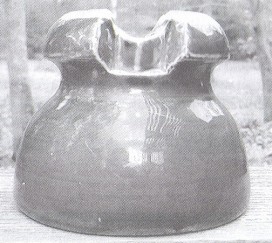
Thomas U-570 with unusual crown detail.
Jarl Anderson
(NIA #755) sent some nice photos of two interesting insulators he recently
acquired. I mistakenly thought we had previously reported this first insulator.
Ben Kirsten was the first to report M-2321. Ben and Jarl apparently found
several damaged M-2321's on the same line in southwestern Colorado. All of the M-2321's had a cast iron Smith Grip pin cemented in the pinhole with a large
U-bolt that secured it to the crossarm. The insulators are unmarked but the
characteristics indicate they were made by the Lima Insulator Co. (1904-1908).
Unfortunately all of the insulators Ben and Jarl found were damaged but
they still make nice specimens as you can see in Jarl's photographs. There is an
embossed marking on the fluted sides of the cast iron pin: PATENT / AP'D FOR /
SMITH / GRIP. The bottom of the Smith Grip pin is slightly concave and has two
extensions that grip the crossarm so the bracket will not turn. William Smith
was granted patent No. 878,679 on February 11, 1908 for this unique pin.
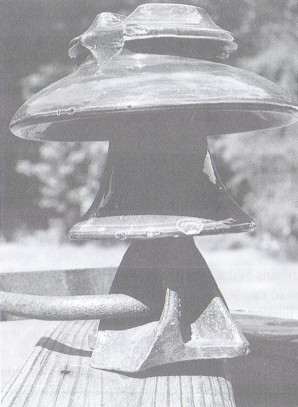
M-2321 mounted on a Smith Grip pin.
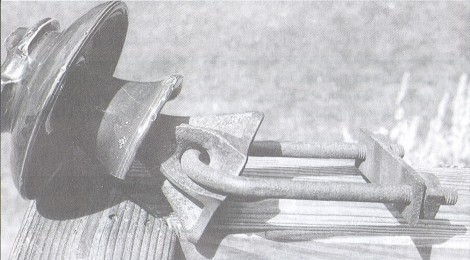
M-2321 showing complete Smith Grip pin assembly.
Jarl said he found an unusual
spool-type dead-end bracket in southern Maine on a downed pole along a railroad
track. I looked through a number of catalogs and could not find this specific
bracket. The solid porcelain spool insulators are designed with extensions on
each end that fit into the round holes in the bracket and held securely when it
is bolted together. The bracket was bolted at a right angle to a crossarm by
means of the long bolt in the center. Apparently the brackets were used in
dead-ending service. Jarl found four brackets with medium and dark brown spools.
The medium brown spools on two of the brackets were unmarked. The dark brown
spools were marked with "U" inside a circle on one end and the Line
Material marking on the other end. The Line Material marking is a "LM"
inside a triangle that is inside a circle. The "U" marking was used by
Universal Clay Products Co., Sandusky, OH which made the insulators for Line
Material.
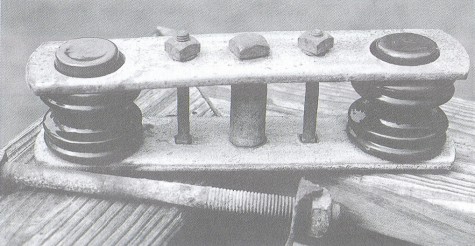
Unusual dead-end Line Material bracket with solid porcelain spools.
Dennis Stewart reported some very nice old multipart porcelain insulators in
the past and he continues to make some interesting reports. Some time ago he
sent me photographs of three very old classic multiparts that you will find
interesting. The first one is M-2154 that was made by Pittsburg in the 1910's.
This is a very small multipart with a lily-shell bottom skirt. The glaze color
is dark but the top skirt is lighter with a pretty speckled glaze.
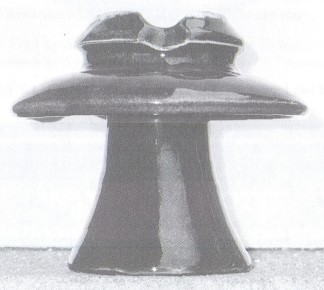
Unmarked M-2154 made by Pittsburg.
The next insulator is M-2636 that has a nice long lily-shell bottom skirt and
a curved petticoat under the top skirt. What makes this one so unusual and rare
is the incuse marking on the side of the crown: JOHNS-MANVILLE. These were made
by the New Lexington High Voltage Porcelain Co. (1903-1912). The marking is very
rare on multipart porcelain insulators. All of the multiparts I have seen with
the Johns-Manville marking have an odd, slightly mottled, brown glaze similar to
German chocolate. It is not particularly attractive but the rare marking and
classic lily-shell style more than make up for it. The glaze on Dennis' M-2636
appears prettier than most J-M multiparts AND it is one of two M-2636 known with
that marking!!!
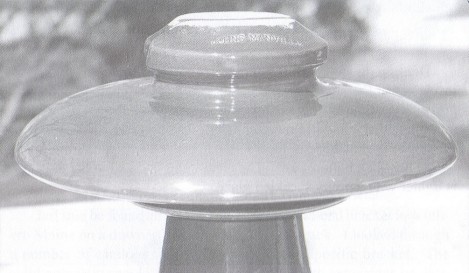
One of two known M-2636's with JOHNS-MANVILLE marking.
The last photograph that Dennis sent is of his unmarked M-2635. I wish you
could see the beautiful tan glaze. It appears as though either Lima or Fred
Locke could have made it and I would guess circa 1904-1905. I have an M-2635
that has a much darker, finely speckled glaze and a small incuse "Y"
under the top skirt. I don't remember seeing a multipart insulator with this
letter marking but two specific styles of unmarked Fred Locke unipart insulators
(made after he left the company in late 1904) have letter markings. White
U-379's have small incuse or "Z" on one of the ears and white U-380's
have a small incuse "Y" on one ear. Hugh Barbour reported an incuse
"L" on unmarked Fred Locke U-192A's and at least one U-964 he found in British
Columbia. I also have a U-964 with the "L" marking under the top
skirt.
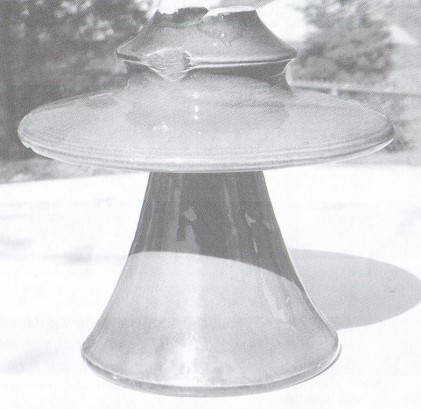
Beautiful unmarked M-2635 has a light tan glaze.
| 